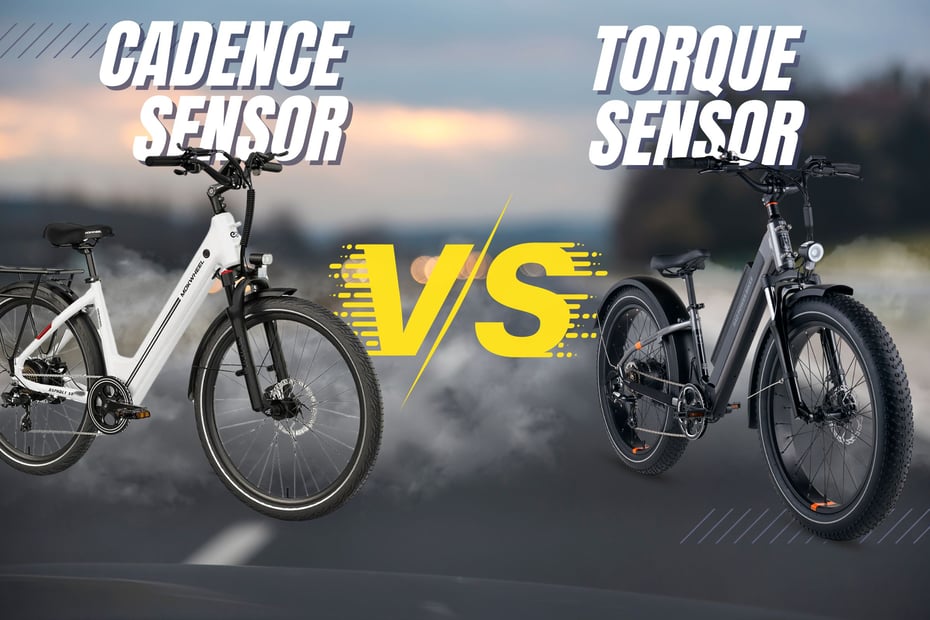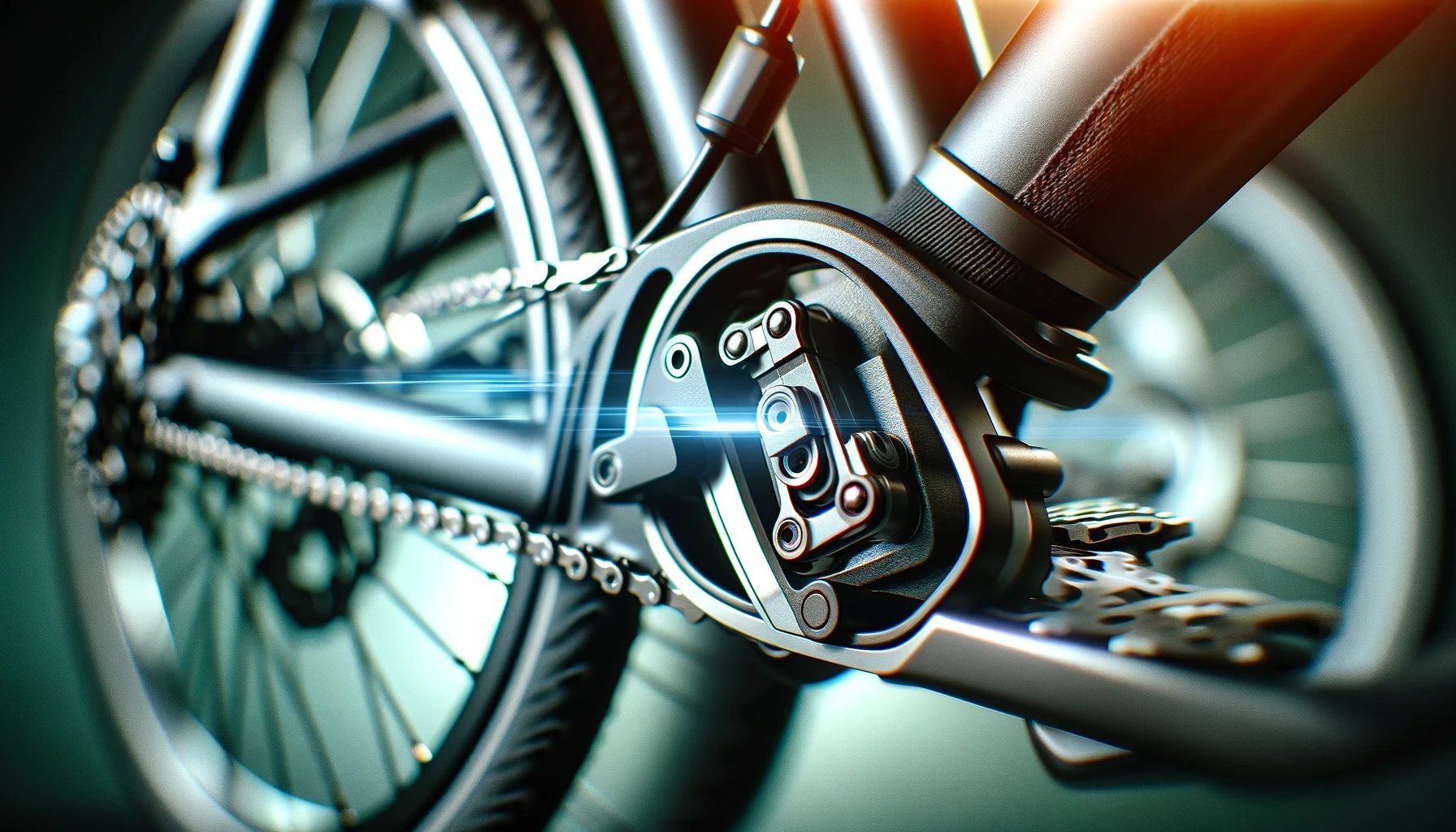Electric bikes are complicated enough. Torque Sensing Vs. Cadence Sensor – which one is better? We’ll tell you in this easy-to-understand guide.

Imagine this: you’re cruising down a scenic path, the wind gently whooshing past, and you’re on your trusty two-wheeler. But wait, this isn’t your average bike ride. You’re on an electric bike (e-bike), where each pedal brings a burst of power, making you feel like a superhero with every push. It’s the magic of pedal assist systems that turns a seemingly ordinary bike ride into an exhilarating adventure.
E-bikes have zoomed into the spotlight as a fun, eco-friendly way to zip around town. But here’s where it gets interesting. At the heart of this pedal-powered revolution are two sidekicks: the Torque Sensing and Cadence Sensor Pedal Assist systems. Think of them as the secret sauce that gives your e-bike that extra zing. Both have the same mission – to make your ride smoother and less sweaty – but they go about it in their own unique ways.
So, grab your helmets, folks, because we’re about to embark on a ride through the ins and outs of these two pedal assist systems. Whether you’re a seasoned e-biker or just e-bike curious, understanding the difference between these systems is key to finding your perfect cycling companion.
Understanding Pedal Assist Systems

Hold up, let’s put the brakes on for a sec. Before we dive into the nitty-gritty of torque sensing and cadence sensors, let’s get a handle on what pedal assist in an e-bike really means. Imagine you’re pedaling uphill, the kind of steep hill that would normally have you huffing and puffing like the Big Bad Wolf. Now, picture an invisible force gently pushing you along, making that uphill battle feel more like a breezy glide. That, my friends, is pedal assist at work.
What is Pedal Assist?
Pedal assist is this super cool feature in e-bikes that gives you a power boost as you pedal. It’s like having a friendly tailwind that’s always there when you need it. This system senses your pedaling and kicks in a motor to help you out. It’s not doing all the work for you (sorry, couch potatoes), but it’s taking the edge off, especially when you’re tackling those pesky hills or feeling a bit tired.
The Two Main Types
| Feature | Torque Sensing | Cadence Sensor |
|---|---|---|
| How it works | Measures pedal force | Detects pedaling motion |
| Amount of assistance | Proportional to pedal force | Fixed amount |
| Riding experience | More natural and intuitive | Simpler and more relaxed |
| Responsiveness | More responsive | Less responsive |
| Cost | Typically more expensive | Typically less expensive |
| Best suited for | Riders who want a more engaging riding experience, riders who frequently ride in hilly or challenging terrain | Casual riders who are looking for a more relaxed pedaling experience |
Now, in the pedal assist universe, there are two stars that shine the brightest: the Torque Sensing and the Cadence Sensor systems.
- Torque Sensing: This one’s a bit of a show-off. It’s all about measuring how much oomph you’re putting into your pedaling and matching it with just the right amount of boost. The more you push, the more it helps, making your ride feel super smooth and intuitive. It’s like your bike is reading your mind (or at least your muscles).
- Cadence Sensor: The Cadence Sensor system is all about detecting your pedal movement. It’s not about how hard you’re pedaling, but rather just that you are. This sensor keeps an eye on your pedaling action, and as soon as it detects motion, it springs into action, delivering a fixed level of power to the motor.
- What’s intriguing about the Cadence Sensor is its sensitivity. A slight turn of the pedals is enough to trigger the sensor, leading to an immediate response from the motor. This can make the bike feel a bit more eager, ready to jump in with power at the slightest hint of pedal movement. It’s like having a highly attentive assistant, always on standby to give you a boost the moment you start moving.
Torque Sensing Pedal Assist: A Deeper Dive

The Tech Behind the Torque
Torque Sensing Pedal Assist is like the secret sauce that adds zing to your ride. It’s a bit like having a keen observer who not only sees you pedaling but also feels how hard you’re working. This system measures the actual force you apply to the pedals and responds with a proportional level of assistance. The harder you pedal, the more it helps you, creating a harmonious dance between your efforts and the bike’s response.
Why It Feels So Natural

The beauty of this system lies in its ability to mirror your pedaling style. It adjusts seamlessly to your input, offering a dynamic and intuitive riding experience. It’s akin to having a biking buddy who matches your pace stride for stride, making the ride feel more like an extension of your own efforts rather than a mechanical boost.
Ideal for the Adventurous and the Athletic
Torque sensing is particularly well-suited for those who love a bit of a challenge. If you’re the kind who relishes hilly terrains or thrives on pushing your limits, this system is your ally.
It’s especially handy when you need varying levels of assistance, depending on the terrain or your energy levels. This dynamic adaptability makes it a favorite among more serious cyclists and adventurers seeking a more engaged riding experience.
Torque Sensor eBikes
E-bikes with torque sensors are increasingly popular for their responsive and intuitive riding experience. However, even the torque-sensing e-bikes vary a great deal.

The Velotric T1 (read our full Velotric T1 Review) is a beast in it’s own right. It’s torque sensor enhances the riding experience by matching the power to the rider’s pedaling effort, giving a natural feel akin to a regular bike but with added power.
This bike is all business, in the best possible way. Made from high-quality materials, this is more of a high-quality bicycle with some extra boost than an eBike.
Lacking a throttle, this bike is geared towards those who prefer an active ride, feeling the effort and reward of cycling, while enjoying a modest boost. The T1’s design focuses on integrating e-bike technology subtly, maintaining the aesthetics and feel of a traditional road bike.

Another bike we’ve reviewed recently, the Mokwheel Asphalt ST, also features a torque sensor. But this one also has pedal assist.
Meet the Asphalt ST, your trusty electric steed for daily commutes. It's got an upgraded tail light and torque sensor, turning your ride into a safety-enhanced, ultra-smooth journey. 🚴♂️
A Note on the Price
All this sophistication does come at a cost. Typically, torque sensing systems are pricier than their cadence-sensing counterparts. But for many, the investment is worth it for the enhanced riding experience and the closer connection it offers between rider and bike.
In our next section, we’ll switch gears and explore the Cadence Sensor Pedal Assist system, which offers a different but equally valuable riding experience. Stay tuned to find out if it’s the right fit for your e-biking adventures! 🚵♀️💨🌄
Cadence Sensor Pedal Assist: Not as predictable
The Art of Fine-Tuning
At the heart of the Cadence Sensor Pedal Assist system lies a balance of technology and customization. This system operates using magnets to detect pedal movement.
However, not all cadence sensors are created equal. The real difference lies in how manufacturers fine-tune these sensors. Some use fewer magnets, resulting in a more immediate and robust response, while others use more magnets for a smoother, more gradual engagement.
Magnets… yes, magnets.
The number of magnets used directly influences how the system reacts to your pedaling. With more magnets, the sensor can detect smaller increments of movement, leading to a gentler, more controlled boost. This subtlety can significantly reduce the jolt you feel when the motor engages, providing a smoother riding experience.
On the flip side, fewer magnets might result in a more pronounced and immediate response from the motor. This setting can be preferable for riders who like to feel a noticeable surge of power as soon as they start pedaling.
Manufacturer’s Motor Tuning
It’s not just about the magnets. The manufacturers also play a crucial role in how they tune the motor in response to the sensor’s trigger. They can configure the motor to deliver a softer or more aggressive boost with each pedal turn. This tuning can drastically change the feel of the bike, from a gentle nudge to a more vigorous push, depending on the rider’s preference.
Affordability Meets Ease of Use

One of the most appealing aspects of the Cadence Sensor system is its affordability. Generally less expensive than torque sensing systems, it offers a budget-friendly option for those venturing into the world of e-bikes. Combined with its ease of use, it’s a popular choice for e-bike newbies or those who prioritize cost-effectiveness and straightforward functionality.
A Spectrum of Sensations
This variability means that the Cadence Sensor system offers a spectrum of riding experiences. Whether you prefer a subtle assist that gently comes to your aid or a more immediate boost that propels you forward, there’s likely a cadence sensor setup that matches your style.
Bikes Using Cadence Sensors

Most of the e-bikes sold today are equipped with cadence sensors, but there’s a growing trend towards incorporating torque sensors as well.
One of our best fat tire ebikes, the RadRover 6+ features a finely tuned cadence sensor. Read our full RadRover 6 Plus Review for more information.
The flagship RadRover gets a massive upgrade. From a brand new frame to the dual-screen Rad User Interface, this bike keeps the spirit of previous RadRovers and but innovates in all the right places.

However, some other bikes, like the KBO Breeze, offer a slightly less refined experience (but a cheaper price tag).
If you are a super careful rider, I’d stay away from bikes like the breeze that take off, well.. in a breeze.
Comparative Analysis: Torque Sensing vs. Cadence Sensor Pedal Assist
Now that we’ve explored the ins and outs of both Torque Sensing and Cadence Sensor Pedal Assist systems, let’s put them head-to-head and see how they stack up against each other. This comparison will help you understand which system aligns best with your riding preferences and needs.
Responsiveness and Riding Experience

- Torque Sensing: Known for its responsiveness, the torque sensor adjusts the motor power based on the force you apply to the pedals. This results in a more dynamic and engaging ride, closely mimicking the experience of riding a traditional bike. It’s great for those who want their effort to directly influence their speed and enjoy a more active riding style.
- Cadence Sensor: With its focus on pedal movement rather than force, the cadence sensor offers a consistent level of assistance regardless of how hard you pedal. The experience can vary significantly based on the sensor’s tuning and the number of magnets used. Some setups provide a smoother transition, while others offer a more noticeable boost. This system is ideal for riders looking for a predictable and steady assist, particularly for relaxed or casual riding.
Terrain and Usage

- Torque Sensing: Excelling in varying terrains, especially hilly or challenging landscapes, torque sensing systems offer a more adaptable ride. They’re a top pick for cyclists who face diverse riding conditions or who seek a more exhilarating and physically engaging experience.
- Cadence Sensor: This system is well-suited for flat terrains or for riders who prefer a more uniform riding experience. It’s a popular choice for urban commutes, leisurely rides, or for those new to e-biking.
Cost Considerations

- Torque Sensing: Generally more expensive due to its advanced technology and the nuanced riding experience it offers. This system is often preferred by enthusiasts or those willing to invest in a higher-end e-bike.
- Cadence Sensor: Typically more affordable, making it an attractive option for budget-conscious riders or those just dipping their toes into the world of e-bikes.
Cadence Sensing vs. Torque Sensing: Which is better?

Choosing between Torque Sensing and Cadence Sensor Pedal Assist comes down to your personal riding style, budget, and the kind of experience you’re looking for. If you’re all about that authentic, responsive biking feel where your effort is directly mirrored, and you don’t mind splurging a bit, the Torque Sensing system is your go-to. It’s tailor-made for the enthusiasts and the adventure-seekers.
| Feature | Torque Sensing | Cadence Sensor |
|---|---|---|
| Operating Mechanism | Detects and measures the actual force applied by the cyclist on the pedals, adjusting power assistance accordingly. | Identifies the action of pedaling, triggering a consistent level of motor assistance regardless of pedaling force. |
| Assistance Variation | Provides variable assistance directly proportional to the rider’s pedal force, offering a dynamic cycling experience. | Delivers a constant, unchanging level of assistance whenever the rider is pedaling, for a uniform ride. |
| User Experience | Creates a more engaging and natural feeling similar to traditional biking, with power assistance that adjusts to pedaling intensity. | Offers a straightforward and relaxed riding experience, perfect for leisurely rides or simple commutes. |
| System Responsiveness | Highly responsive to rider input, offering immediate and proportional assistance for an intuitive riding feel. | Less responsive to pedaling force; provides a steady assist level that’s independent of pedaling intensity. |
| Price Point | Generally involves a higher cost due to the complex sensor technology and refined user experience it offers. | More budget-friendly, offering a cost-effective solution for those seeking basic electric bike functionality. |
| Ideal User Profile | Well-suited for enthusiastic cyclists and adventurers who seek a connected and active riding experience, especially on varied terrains. | Perfect for casual riders and beginners who prefer a simple, easy-to-use system for relaxed and effortless biking. |
On the flip side, if you’re cruising into the e-bike world looking for a relaxed, consistent ride without breaking the bank, the Cadence Sensor system might just be your perfect match. It’s simple, straightforward, and does the job neatly, especially for casual rides or daily commutes.
In the end, it’s all about what makes your ride enjoyable and suits your cycling lifestyle. Whether you lean towards the intuitive push of a torque sensor or the steady assistance of a cadence sensor, each system opens up a world of possibilities, making your e-biking journey unique and exciting. So, pedal on and enjoy the ride your way! 🚴♀️🌟🛣️
Also, check out our guide to the best eBike brands and the best eBike Accessories.





